Moving Workshop Table
Posted 16 May 2019
This is the introductory page for a paid video series. Want to watch more of this project? Select the best option below to get started.
In this series, Paul will be showing you how to make a Moving Workshop Table. Paul delivers a perfect project that will help support you in your everyday work in your workshop. The main super structure of this bench is built in Pine and has a laminated Plywood worktop. The addition of using Plywood creates a robust and sturdy base for those tough jobs. The joinery within this project is the most widely used joint in the world – the perennial Mortise and Tenon joint. The frame consists of, not only stopped mortise and tenon joints, but haunched mortise and tenon joints as well. These joints give the table that added strength and integrity that won’t combust under pressure. This project is a perfect start for those who are looking to get into Table making. With this design you can move on to creating your own wide range of tables such as dining tables or even kitchen tables!
If you have a hunch you’ll need help with your haunches, head over to Common Woodworking and take a look at our easy to follow guide on Haunched Mortise and Tenon joints (https://commonwoodworking.com/courses/joint-variation-haunched-mortise-and-tenon/).
You’ll also find advice on how to glue up table top laminations, which will help if you are new to the process (https://commonwoodworking.com/gluing-up-a-table-top-boards/).

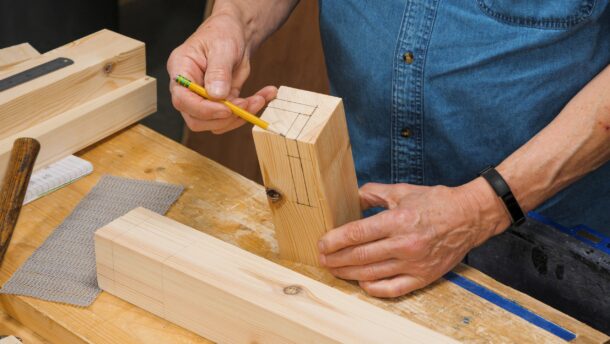
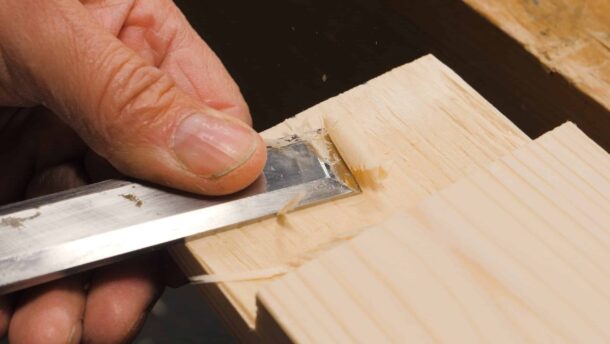
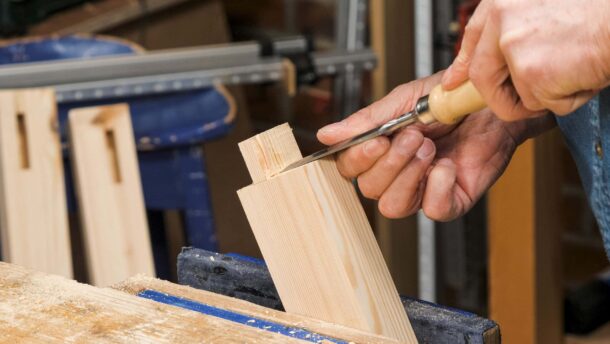
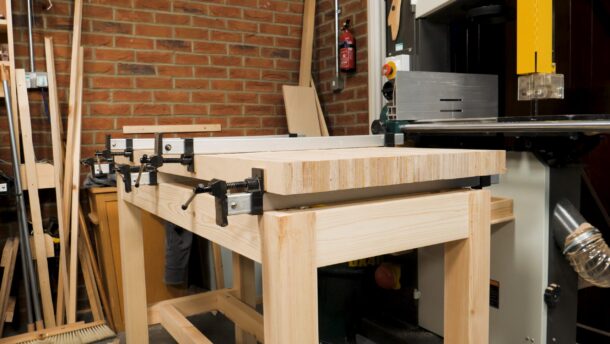
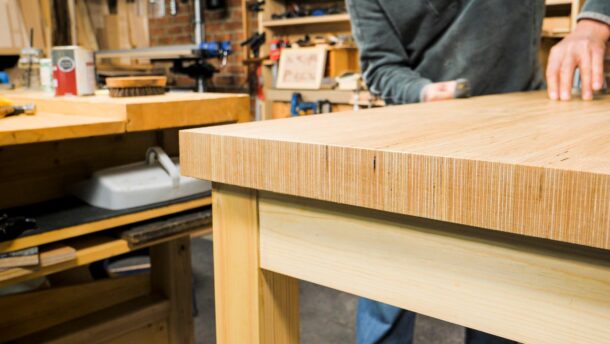
That’s a nice looking shop table. Easily customizable to whatever size a person wants.
Please can we agree not to rehash the anti plywood comments we have seen recently?
I second that
Great project. It would be very useful in almost any shop or on a job site.
I am looking forward to the new videos.
Hi Paul and crew,
Very useful project, definitely on my to do list. Just to make you aware the metric measurement of the tabletop length in the drawing is incorrect, it reads 2170mm tho im pretty sure it should be 1270.
Keep up the great work guys, looking forward to the rest of this project.
Thanks, Paul! We’ve corrected the measurement almost seamlessly using information technology.
I am thinking about using Douglas fir for this project . Any one have any idea how this wood works with hand tools?
Like butta.
Sounds good thanks Steve
Doug fir works well with hand tools, but two things to keep in mind. Though the wood is soft, the grain can sometimes be very hard. I have had trouble planing end grain on a shooting board with a few pieces because of that hard grain. That, of course, turns on the orientation of that end grain when you are shooting. Also, Doug Fir can tear like pine when chopping mortises and dovetails so tools need to be sharp.
Hi,
Paul says it works fine with hand tools no problem.
Kind Regards,
Izzy
Douglas-fir is beautiful. And, yes, it can work like butter, but a few things to keep in mind with Douglas-fir.
1. Due to its very long fibers and hard and soft grain (early wood and late wood), it can give really nasty – and long – splinters. For the same reason, it is more subject to tear-out than other woods. So, be mindful of grain direction.
Two of the nicest grain patterns – vertical and flame grain – can be particularly troublesome for splinters and tear-out.
2. It bruises. And that bruising can be more than skin deep and not easily taken out with sanding or planing the surface.
You might not notice the bruising until you put a finish on it, and then will wonder why it looks blotchy.
So, careful if/when you strike it with anything. This would not be the best wood for Paul’s favorite use of his mallet.
3. It gets hard and brittle with age.
This can make it easily fracture if you are disassembling and reassembling something or trying to salvage older pieces, for example, and makes the splintering problem worse. If you are using nails, it is highly advisable to drill first.
4. Pitch pockets
D-fir commonly has pitch pockets. Use of shellac is HIGHLY recommended to seal in the pitch. Otherwise, it can ooze out for at least a hundred years (seriously).
5. Darkens with exposure to light.
Though this may be a desirable feature, it is worth being aware of. Probably not an issue for a project like this, but if you are using it for flooring, for example, area rugs can leave geometric patterns. To my knowledge, unlike cherry, you can’t really ‘pre-condition’ the darkening by simply putting it out int he sun for a day or so.
Thank you for doing a project like this! I always try to get new idea to improve my small garage workshop and i can see a lot of usefulness in here!
Hello,
I noticed that the top rails do not have a full haunch but a slanted one. Can you please explain what is the difference? When do we use one or the other? In general what is the purpose of haunches anyway.
Thanks for your response.
Hi @woodturner
My dad touches on this briefly in the second episode. It is sort of a halfway haunch. It adds more strength than leaving it off would but is less effort. We are trying to show some slightly nuanced techniques that might not be used in furniture making but are appropriate for workshop fixtures. There may not be a huge difference but there is a slight time saving element which adds up given the number of joints.
Best,
Joseph
Thank you Joseph.
Thanks Joseph. I appreciate the nuanced info. In some respects getting nuanced info is the hardest part of online learning. I appreciate it when Paul puts it into his videos.
Does anyone who’s made this have any thoughts as to whether it would be sturdy enough for, say, mounting a midi lathe?
Hello,
A little late to this thread but, I’ve noticed Paul has a few of these work tables in the background with a sleek looking gray top contrary to the plywood in the tutorial. What material/finish is that? He seems to have used it more than a few times.
Thanks
Hi Peter,
Paul says:
My finish on the two tables you are talking about or simply painted with a water-based paint.
Izzy
Beginner woodworker just venturing out past boxes and practices joins and I am enjoying this project so far! One thing I have noticed is the difference in readily available stock wood sizes in the US vs UK. Here in Colorado it seems you either have 2×2 (really 1.5×1.5) or 4×4 stock (really 3.5×3.5) which over an 8ft span is a jump from 18 cubic inches to 98 (~5x more wood!). I am jealous of the 3x3s that seem available in the UK. The obvious solution is just buy 4x4s and re-saw by hand (or bandsaw if you have one) but I also think I must not be the first US based woodworker not wanting spindly nor massive legs. Is it just my area that seems to have no 3x3s? Curious how others have approached this
Hi Peter,
Paul says:
It is always surprising stateside to see out standard wood sizes, and dare I say frustrating that our 2×2 are actually fatter at 1 ¾” by 1 ¾” and so on. There is no way to bridge the gap in differences as all US timber seems geared up for construction and in particular stick housing schedules which we and mainland Europe would likely never endorse. I don’t have an answer for you as I just made up the differences by laminating stock.
Also, as a side, when we see the aftermath of hurricanes and tornadoes, floods etc in the USA, we always feel devastated at such damage, but for those of us who lived in the US culture we’re never surprised that when heavy winds huff and puff the houses are indeed blown down in vast swathes.
Izzy